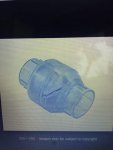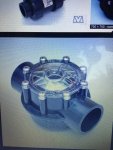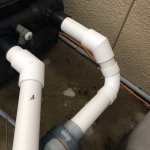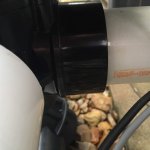check valve differences
- Thread starter tstex
- Start date
You are using an out of date browser. It may not display this or other websites correctly.
You should upgrade or use an alternative browser.
You should upgrade or use an alternative browser.
- May 23, 2015
- 24,403
- Pool Size
- 16000
- Surface
- Plaster
- Chlorine
- Salt Water Generator
- SWG Type
- Pentair Intellichlor IC-60
Well; i have 4-5 Jandy valves and one of the non serviceable or not to cool valve. The clear one is what separates the puck machine from the heater to prevent concentrated CL from backing into heater. I only use the pucks when i need to increase my CYA or I'm leaving town and none of my TFP pals will come over to dispense some liquid bleach 
- May 23, 2015
- 24,403
- Pool Size
- 16000
- Surface
- Plaster
- Chlorine
- Salt Water Generator
- SWG Type
- Pentair Intellichlor IC-60
Well; i have 4-5 Jandy valves and one of the non serviceable or not to cool valve. The clear one is what separates the puck machine from the heater to prevent concentrated CL from backing into heater. I only use the pucks when i need to increase my CYA or I'm leaving town and none of my TFP pals will come over to dispense some liquid bleach
If you leave out a margarita machine with an ample supply of ice and booze, WoodyP will be more than happy to take care of your pool....
cfherrman
TFP Guide
Checks are not perfect and over time they will leak, one requires a hacksaw, the other, screwdriver
Checks are not perfect and over time they will leak, one requires a hacksaw, the other, screwdriver
That seems to put it into pretty good perspective....I guess I'm going to need some couplers and PVC sometime in the near future
How can you tell if a ck valve is starting to fail ???
- May 3, 2014
- 58,361
- Pool Size
- 6000
- Surface
- Fiberglass
- Chlorine
- Salt Water Generator
- SWG Type
- Pentair Intellichlor IC-40
You can tell it is failing if it no longer 'checks' the flow of water it was installed to control.
You can tell it is failing if it no longer 'checks' the flow of water it was installed to control.
Ho ho ho
cfherrman
TFP Guide
Aside from holding prime in a pump, typical slight leakage from a check should not be a problem.
How can you tell if a ck valve is starting to fail ???
Depends on where it's plumbed and what it's used for. I have two check valves: One on the output of my heater to prevent super chlorinated output from the SWG from backing into the heater as you mentioned and also on my output side for my spa.
I have a raised spa that spills into the pool which the pool's water level is a few feet lower than my spa. The check valve on my plumbing output is vital to maintain the water level in the spa to the tile line when the pump is off. My water level has been slowly lowering in the spa so the check valve needs to be replaced as the leaky check valve allows enough water to seep by into the pool overnight so that there are a few inches of exposed spa plaster (I have mini-pebble) by the next morning. I have the Jandy valve pictured above as the replacement piece is only $25 on Amazon and as mentioned is an easy fix. (search Jandy 7056 on Amazon) My equipment is about 5 years old now so $25 every 5 years is not much to worry about.
What's cool about the Jandy check valve is that FloVis makes a retrofit meter that drops right into the Jandy 2" - 2 1/2" check valves that serves both purposes. (Amazon for $115) Nice for calculating run time for variable speed pumps. But since my output plumbing is split between pool and spa output, that won't be a good place for the meter retrofit to get an accurate reading so only the $25 replacement will go there. The meter retrofit I'll put in on the heater output side check valve. (datsaheet says it's rated up to 140 degrees F)
How big is your SWG? Most SWG’s will take hours to create 3-4ppm of FC, that is hardly ‘super chlorinated’. Also, if you have your SWG cell set to run within the running time of your pump, the cell will shut off before the pump, so the pump will have time to ‘flush out’ the cell.Depends on where it's plumbed and what it's used for. I have two check valves: One on the output of my heater to prevent super chlorinated output from the SWG from backing into the heater ..........
But back on topic, I believe that the Jandy style check valves also create much less system back pressure compared to the ‘sealed’ type.
Depends on where it's plumbed and what it's used for. I have two check valves: One on the output of my heater to prevent super chlorinated output from the SWG from backing into the heater as you mentioned and also on my output side for my spa.
I have a raised spa that spills into the pool which the pool's water level is a few feet lower than my spa. The check valve on my plumbing output is vital to maintain the water level in the spa to the tile line when the pump is off. My water level has been slowly lowering in the spa so the check valve needs to be replaced as the leaky check valve allows enough water to seep by into the pool overnight so that there are a few inches of exposed spa plaster (I have mini-pebble) by the next morning. I have the Jandy valve pictured above as the replacement piece is only $25 on Amazon and as mentioned is an easy fix. (search Jandy 7056 on Amazon) My equipment is about 5 years old now so $25 every 5 years is not much to worry about.
What's cool about the Jandy check valve is that FloVis makes a retrofit meter that drops right into the Jandy 2" - 2 1/2" check valves that serves both purposes. (Amazon for $115) Nice for calculating run time for variable speed pumps. But since my output plumbing is split between pool and spa output, that won't be a good place for the meter retrofit to get an accurate reading so only the $25 replacement will go there. The meter retrofit I'll put in on the heater output side check valve. (datsaheet says it's rated up to 140 degrees F)
JV, great explanation - thank you...my biggest concern would be the clear glass Ck-Valve that prevents back-flow of concentrated CL into the heater...As an avid TFP chemistry follower, I only use the puck dispenser when I need to add CYA [and get a break from adding bleach] and when we as a family travel. But, the latter has been a rarity bc the Hayward ecostar-less VSP trips the breaker and hence a green pool...
as stated, my biggest concern is the copper heat-exchanger w concentrated CL back-flowing and how to detect that other than my heater not working and damage after the fact - my equip pad is 37 months operable, so next winter I might replace the clear valve w the jandy and highly consider the FloVis meter for the jandy valve. I'd be interested in how long these have been in production and if there's a 5-yr history to determine if they work well?
Thanks again jv, tstex
- May 3, 2014
- 58,361
- Pool Size
- 6000
- Surface
- Fiberglass
- Chlorine
- Salt Water Generator
- SWG Type
- Pentair Intellichlor IC-40
With a puck feeder/chlorinator, you do need a check valve between it and your heater. The pucks continue to dissolve even with the pump off. With a SWCG, the chlorine production ceases when the pump stops flowing (you must have a method to remove power to the SWCG when the pump is off).
A flow meter is a novelty, but not necessary. You need to run your pump at whatever speed and for however long it takes to clean the pool, generate chlorine if using a SWCG, and that is it. Turnovers mean nothing.
Take care.
A flow meter is a novelty, but not necessary. You need to run your pump at whatever speed and for however long it takes to clean the pool, generate chlorine if using a SWCG, and that is it. Turnovers mean nothing.
Take care.
Thanks Marty.
I do have a Ck valve btw puck dispenser & heater. It's the clear one pictured, so inevitably it will need to be cut out and replaced. My question is when?
I don't use the puck dispenser except for maybe 3-4 times a year only to mainly raise CYA. Thanks
I do have a Ck valve btw puck dispenser & heater. It's the clear one pictured, so inevitably it will need to be cut out and replaced. My question is when?
I don't use the puck dispenser except for maybe 3-4 times a year only to mainly raise CYA. Thanks
Thanks Marty.
I do have a Ck valve btw puck dispenser & heater. It's the clear one pictured, so inevitably it will need to be cut out and replaced. My question is when?
I don't use the puck dispenser except for maybe 3-4 times a year only to mainly raise CYA. Thanks
I repaired my check valve (I have the Jandy "use a screwdriver" type) when my spa started to drain down last year. I am not sure how to tell when yours is down, but I would say that the screw-front type is 100% the way to go. Took me a few bucks and 3 minutes to repair the flapper and stop the back leaking.
cfherrman
TFP Guide
Thanks Marty.
I do have a Ck valve btw puck dispenser & heater. It's the clear one pictured, so inevitably it will need to be cut out and replaced. My question is when?
I don't use the puck dispenser except for maybe 3-4 times a year only to mainly raise CYA. Thanks
Do you have unions up the line from that check? You could pop the union monthly to yearly and check it's backflow.
My question is when?
Tx,
Well I say 2 years, 3 months, 14 days, 8 hours, and 30 seconds from now...
And my 'guess' is just about as good as anyone else's.....
Sorry, but I don't believe there is anyway to know for sure..
Thanks,
Jim R.
ok guys, I think I have a plan...
Whenever Jandy ck valves go on sale, I'll buy one...I'm sure this is a Union at the heater [pic 1], but not sure about this one at the puck disperser [P 2].
If only a union at the heater, I can take off there, cut out the clear ck valve btw puck and ck valve w enough pvc on both sides for couplings, then size it all so the union can put all back on w the correct sizing...sound like a plan? thanks
Whenever Jandy ck valves go on sale, I'll buy one...I'm sure this is a Union at the heater [pic 1], but not sure about this one at the puck disperser [P 2].
If only a union at the heater, I can take off there, cut out the clear ck valve btw puck and ck valve w enough pvc on both sides for couplings, then size it all so the union can put all back on w the correct sizing...sound like a plan? thanks
Attachments
Thread Status
Hello , This thread has been inactive for over 60 days. New postings here are unlikely to be seen or responded to by other members. For better visibility, consider Starting A New Thread.
Similar threads
- Replies
- 5
- Views
- 266
- Replies
- 9
- Views
- 146
- Replies
- 6
- Views
- 117
- Replies
- 8
- Views
- 205





